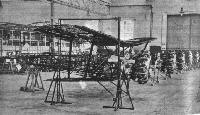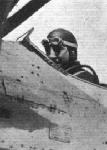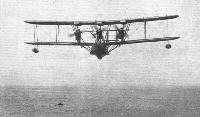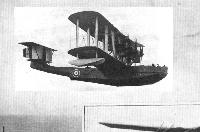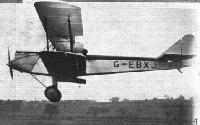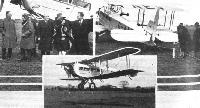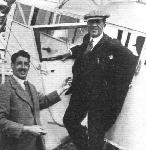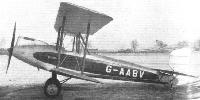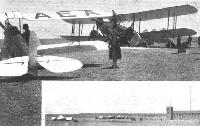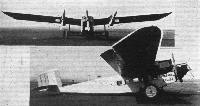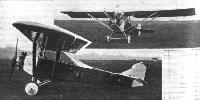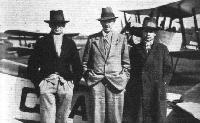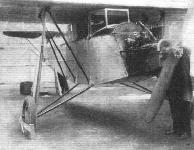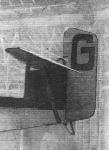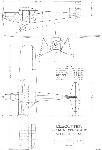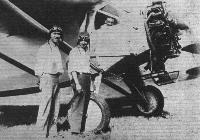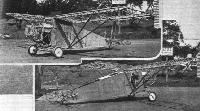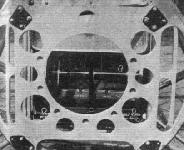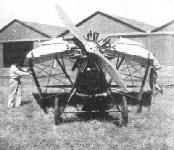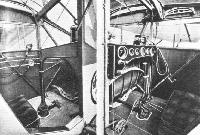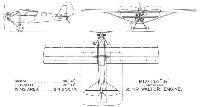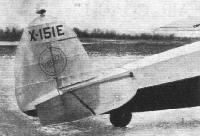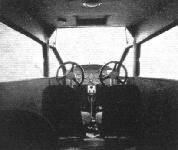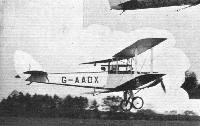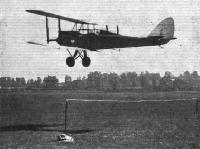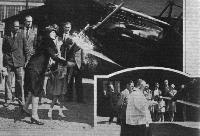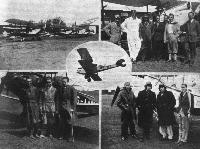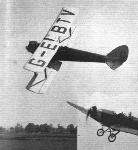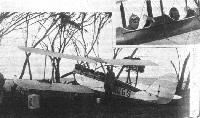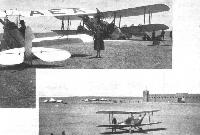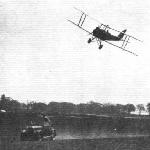Фотографии
-
AT THE BRISTOL CLUB MEETING: Mr. Cyril Uwins shows off to good advantage the Bristol "Bulldog" ("Jupiter") single-seater fighter.
Самолёты на фотографии: Bristol Bulldog - Великобритания - 1927
-
METAL CONSTRUCTION: The photo shows the erection of Bristol "Bulldog" all-steel single-seater Fighters at the Filton works of the Bristol Aeroplane Co., Ltd. An order for a number of these machines has just been obtained from Latvia.
Самолёты на фотографии: Bristol Bulldog - Великобритания - 1927
-
HOSTS, PERFORMERS, AND VISITORS: 3, a somewhat futuristic Portrait of Mr. Cyril Uwins in the cockpit of the Bristol "Bulldog."
Самолёты на фотографии: Bristol Bulldog - Великобритания - 1927
-
Armstrong Whitworth "Siskins" ("Jaguars") of No. 29 (Fighter) Squadron zooming.
Самолёты на фотографии: Armstrong Whitworth Siskin - Великобритания - 1921
-
THE SASSOON CUP. The finish, showing Flight-Lieut Lea-Cox, No. 56 Sqdn. (left), and Flying Officer Clarke, No. 29 Sqdn. (right), both on Siskins, with but 2 seconds "between them."
Самолёты на фотографии: Armstrong Whitworth Siskin - Великобритания - 1921
-
Регистрационный номер: J9312 THE SASSOON CUP. The line-up of Siskins and Gamecocks representing 12 Fighter Squadrons.
Самолёты на фотографии: Armstrong Whitworth Siskin - Великобритания - 1921Gloster Gamecock - Великобритания - 1925
-
Mr. H. Penrose, of the Westland Aircraft Co. Ltd., demonstrating the Westland "Widgeon" monoplane above a thick row of spectators and cars at the Northampton meeting.
Самолёты на фотографии: Westland Widgeon - Великобритания - 1924
-
Регистрационный номер: G-AAFD Christening of the Westland "Widgeon" (Gipsy), belonging to the Anglo-American Oil Co., Ltd., at Croydon Aerodrome. Its name, appropriately enough, is "Miss Ethyl."
Самолёты на фотографии: Westland Widgeon - Великобритания - 1924
-
HOSTS, PERFORMERS, AND VISITORS: 2, "Wendy," her portrait, painted on the side of Dr. Whitehead Reid's Westland "Widgeon II."
Самолёты на фотографии: Westland Widgeon - Великобритания - 1924
-
Регистрационный номер: G-AAEV [3] AT THE BRISTOL CLUB MEETING: Sir Alan Cobham, carrying passengers in his D.H. "Giant Moth" ("Jaguar"), has a "Hun on his tail" in the form of the little Klemm monoplane.
Самолёты на фотографии: De Havilland Giant Moth / D.H.61 - Великобритания - 1927Klemm L.25 - L.28 Swallow - Германия - 1927
-
Регистрационный номер: J9479 Fairey monoplane, fitted with Napier "Lion" engine, which flew to India non-stop from Cranwell, in 50 hrs. 48 mins., and only failed to beat the world's record for long distance through strong persistent headwinds. A Fairey metal airscrew was used.
Самолёты на фотографии: Fairey Long-Range Monoplane - Великобритания - 1928
-
Регистрационный номер: J7557 NORWICH AIR DISPLAY: The Beardmore "Inflexible" monoplane of 1950 h.p.
Самолёты на фотографии: Beardmore Inflexible - Великобритания - 1928
-
The Blackburn "Iris" metal flying-boat, three Rolls Royce "Condor" engines
Самолёты на фотографии: Blackburn Iris / R.B.1 - Великобритания - 1926
-
Регистрационный номер: N185 REPRESENTATIVE TYPES OF BRITISH AIRCRAFT: 1. The Blackburn Iris II, with three Rolls-Royce "Condor" engines, is a service flying-boat.
Самолёты на фотографии: Blackburn Iris / R.B.1 - Великобритания - 1926
-
Lady Heath has recently completed a flying tour of several American States on behalf of the American "Cirrus" engine. She flew a Cirrus-Avian and acted as her own pilot, mechanic, and saleswoman. About 3,000 miles were covered, and orders were lodged with her, we understand, for over 100 engines.
Самолёты на фотографии: Avro Avian / Type 594/616 - Великобритания - 1926
-
Mr. Cantrill, in the Avro "Avian," bombing the Austin "Baby."
Самолёты на фотографии: Avro Avian / Type 594/616 - Великобритания - 1926
-
Регистрационный номер: G-EBXJ LANDING IN THE DESPREZ CHALLENGE CUP COMPETITION: 4, Mr. Ashworth, a member of the Nottingham Aero Club, in his Cirrus-Avian.
Самолёты на фотографии: Avro Avian / Type 594/616 - Великобритания - 1926
-
Регистрационный номер: G-AAEV [3] "AIRMINDEDNESS" AT NORWICH: Sir Alan Cobham was busy, both on Sunday and Monday, taking up passengers in the D.H. "Giant Moth" (D.H. 61, Siddeley "Jaguar").
Самолёты на фотографии: De Havilland Giant Moth / D.H.61 - Великобритания - 1927
-
Регистрационный номер: G-AAEV [3] "YOUTH OF BRITAIN": This is the name given to the de Havilland "Giant Moth" (D.H.61) with Armstrong Siddeley "Jaguar" engine on which Sir Alan Cobham has just started a tour of Britain. On this tour Sir Alan will encourage "airmindedness" by giving passenger flights to a number of people. Our photographs show Sir Charles Wakefield "launching" the "Youth of Britain," a group at the launch, including, from left to right. Capt. de Havilland, Sir Alan Cobham, Mr. St. Barbe. Sir Charles Wakefield, Lady Cobham, and Sir Sefton Brancker, and, below, the machine in flight, piloted by Sir Alan Cobham.
Самолёты на фотографии: De Havilland Giant Moth / D.H.61 - Великобритания - 1927
-
THE D.C.A. AT NORWICH: Sir Sefton Brancker alighting from the D.H. "Giant Moth" after a flight with Sir Alan Cobham.
Самолёты на фотографии: De Havilland Giant Moth / D.H.61 - Великобритания - 1927
-
Регистрационный номер: G-AABV Although this new all-metal Blackburn "Bluebird" with D.H. "Gipsy" engine had not completed full experimental trials, Sqdr.-Ldr. L. H. Slatter flew it from London to South Africa in five weeks with scarcely any hitch.
Самолёты на фотографии: Blackburn Bluebird / L.1 - Великобритания - 1924
-
AT MILAN: The Caproni stand, showing the Ca97 three-engined commercial monoplane.
Самолёты на фотографии: Caproni Ca.97 - Италия - 1927
-
This view marks the arrival of Mrs. Hylton Cleaver and Capt. Donald Drew in the former's Gipsy-Moth at Rutbah Wells on April 4 last, during their tour to India. Behind Mrs. Cleaver is the Imperial Airways D.H. "Hercules" (Bristol "Jupiters") "City of Jerusalem" refuelling during the first eastbound Indian Air Mail flight.
Самолёты на фотографии: De Havilland Hercules / D.H.66 - Великобритания - 1926
-
THE NEW ROHRBACH "ROLAND": Two views of the improved machine recently produced. A larger cabin and cockpit and better engine installation are features of the latest type.
Самолёты на фотографии: Rohrbach Ro.VIII Roland - Германия - 1926
-
THE FIAT "A.S.1": Two views of the new Italian two-seater light monoplane. It is fitted with a Fiat 85 h.p A-50 air-cooled radial engine.
Самолёты на фотографии: FIAT AS.1 / AS.2 / TR.1 - Италия - 1928
-
Регистрационный номер: G-AAEY [2] THE "MOTOR-CYCLE OF THE AIR": Two views of a new light monoplane which has just been produced by Lieut.-Col. G. L. P. Henderson (of the Henderson Flying School, Croydon). Designed by Capt. K. N. Pearson, this little machine is powered with a 40 h.p. A.B.C. "Scorpion" engine, and is of all-wood construction - even to the fuselage and wing covering. It is intended to place this machine on the market at a very moderate price.
Самолёты на фотографии: Henderson & Glenny HSF.2 Gadfly - Великобритания - 1929
-
Регистрационный номер: G-AAEY [2] A Good Beginning: The little single-seater monoplane with A.B.C. "Scorpion" engine, produced by Henderson and Glenny, and to which we referred recently, established a world's record last week by reaching a height of 10,400 ft. (uncorrected), piloted by Col. Henderson. Standing in front of the machine are, from left to right, Col. G. L. P. Henderson, Mr. K. N. Pearson (designer), and Mr. Glenny. Experiments are to be made shortly with wings fitted with the Pearson type of lateral control.
Самолёты на фотографии: Henderson & Glenny HSF.2 Gadfly - Великобритания - 1929
-
Регистрационный номер: G-AAGC Самолёты на фотографии: Koolhoven FK-41 - Нидерланды - 1928
-
THE DESOUTTER MONOPLANE: The photograph gives a good idea of the low position of the engine above the ground, which facilitates inspection and adjustments.
Самолёты на фотографии: Koolhoven FK-41 - Нидерланды - 1928
-
THE DESOUTTER MONOPLANE: The somewhat unusual tail layout is shown.
Самолёты на фотографии: Koolhoven FK-41 - Нидерланды - 1928
-
THE DESOUTTER MONOPLANE: Some constructional details. The tubular engine mounting is shown in 1. Note the rubber pads interposed between the engine bearers and the feet of the engine to reduce vibration. A flexible (rubber) connection is made between the aileron crank and its operating tube, as shown in 2. The tail plane adjustment is shown in 3, and the elevator crank in 4. Fig. 5 illustrates the fitting which locates the wing in relation to the fuselage, but which permits deflection of the wing spar. The attachment of lift strut to rear spar is shown in 6.
Самолёты на фотографии: Koolhoven FK-41 - Нидерланды - 1928
-
Desoutter 3 Seater Monoplane Cirrus III Engine
Самолёты на фотографии: Koolhoven FK-41 - Нидерланды - 1928
-
Mr. R. L. Robbins and Mr. J. Kelly with their Ryan monoplane (Wright "Whirlwind" engine) in which they set up an endurance record (under refuelling conditions) of 7 days 4 hrs. 40 mins, 15 secs., or 22 hours above the previous record. They are ex-cowboys!
Самолёты на фотографии: Ryan B-1 Brougham - США - 1927
-
A FLYING-BOAT ON THE NORFOLK BROADS: This photograph shows a Supermarine "Southampton" which recently alighted on Oulton Broad. This is believed to have been the first time in history that a flying-boat has alighted on and started from one of the Broads. In front of the "Southampton" may be seen one of the 24-ft. Brooke 30 m.p.h. "Seacars" ordered for use by the R.A.F. in connection with the Schneider Trophy Contest.
Самолёты на фотографии: Supermarine Southampton / Solent - Великобритания - 1925
-
CRAZY FLYING AT NORTHOLT: Three studies of "Air-Madness" on the part of Flying-Officer Campbell and Flight-Sergt. Brown on Avro-Lynx machines
Самолёты на фотографии: Avro Avro 504N - Великобритания - 1920
-
Регистрационный номер: G-AAID [5] Three-quarter front and three-quarter rear views of the "Robin" in skeleton.
Самолёты на фотографии: ABC Robin - Великобритания - 1929
-
Регистрационный номер: G-AAID [5] An unusual view. This photograph was "shot" through an opening in the engine plate, and shows the control stick, adjustable foot rests, control cable pulleys, etc.
Самолёты на фотографии: ABC Robin - Великобритания - 1929
-
Регистрационный номер: G-AAID [5] The tail of the "Robin" is of orthodox construction and design.
Самолёты на фотографии: ABC Robin - Великобритания - 1929
-
Регистрационный номер: G-AAID [5] The "Robin" undercarriage is of the "split" type, and comprises axle, radius rod and telescopic strut. The shock absorbers are endless rubber rings on "crutches."
Самолёты на фотографии: ABC Robin - Великобритания - 1929
-
Регистрационный номер: G-AAID [5] FRONT VIEW OF THE A.B.C. "ROBIN": Although showing the machine in skeleton, this photograph gives a good idea of the clean lines.
Самолёты на фотографии: ABC Robin - Великобритания - 1929
-
ON THE A.B.C. "ROBIN": The lift strut attachment to the fuselage is shown in 1, and details of the wing construction in 2. In 3 is illustrated the attachment of the lift strut to the rear spar, and in 4 the duralumin tube across the top of the fuselage, and which carries the fork and block for the wing spar attachment.
Самолёты на фотографии: ABC Robin - Великобритания - 1929
-
THE A.B.C. "ROBIN": On the left, a sketch of one of the rear spar hinges, showing how aileron cables are guided. On the right, a front spar fitting, with locking pin.
Самолёты на фотографии: ABC Robin - Великобритания - 1929
-
A.B.C. "Robin" A.B.C. "Scorpion" Engine
Самолёты на фотографии: ABC Robin - Великобритания - 1929
-
Самолёты на фотографии: Breda Ba.15 - Италия - 1928
-
Регистрационный номер: I-AADE THE BREDA 15: View of the new Italian light 'plane.
Самолёты на фотографии: Breda Ba.15 - Италия - 1928
-
THE BREDA 15: View of the new Italian light 'plane as a seaplane.
Самолёты на фотографии: Breda Ba.15 - Италия - 1928
-
The Breda 15: Two views of the interior of the cabin, showing on the right the pilot's or rear seat, and on the left the passenger's, which is in front.
Самолёты на фотографии: Breda Ba.15 - Италия - 1928
-
Breda "15" Lightplane 85 hp. Walter Engine
Самолёты на фотографии: Breda Ba.15 - Италия - 1928
-
Регистрационный номер: X151E [3] THE VERVILLE "AIR COACH": Front view. Note the method of attaching Oleo struts and front wing-braces.
Самолёты на фотографии: Verville Air Coach - США - 1929
-
Регистрационный номер: X151E [3] THE VERVILLE "AIR COACH": View showing the neat tail unit, with wheel
Самолёты на фотографии: Verville Air Coach - США - 1929
-
Регистрационный номер: X151E [3] THE VERVILLE "AIR COACH": Side view of this American commercial monoplane, fitted with a 110 h.p. Warner engine.
Самолёты на фотографии: Verville Air Coach - США - 1929
-
THE VERVILLE "AIR COACH": View showing the interior of the cabin.
Самолёты на фотографии: Verville Air Coach - США - 1929
-
THE SUPERMARINE "SEAMEW": Two views of the Service Version.
Самолёты на фотографии: Supermarine Seamew - Великобритания - 1928
-
Регистрационный номер: G-AADX Mr. A. C. M. Jackaman competing with his familiar Coupe Gipsy-Moth "Peridot III" in the Landing Competition.
Самолёты на фотографии: De Havilland Moth Coupe - Великобритания - 1928
-
Регистрационный номер: G-AACL PENALTY OF FAME: Mr. A. S. Butler who flew his new Coupe Gipsy Moth at the Northampton meeting. Its colours are black and green.
Самолёты на фотографии: De Havilland Moth Coupe - Великобритания - 1928
-
Регистрационный номер: G-AADC LANDING IN THE DESPREZ CHALLENGE CUP COMPETITION: 3, Captain Bayley on his Gipsy-Moth G-AADC
Самолёты на фотографии: De Havilland Moth Coupe - Великобритания - 1928
-
These illustrations mark the occasion, at Stag Lane, of the christening, on April 27, of a "Gipsy-Moth," thought to be the first British aircraft supplied to Yugo-Slavia. The ceremony on the left was performed by Mrs. Banatz, wife of the director of the Yugo-Slav Lloyd Steamship Line. In the group on the right is (left to right): Mr. T. G. Mapplebeck, owner of the machine "Miss Dalmacija"; Mrs. Banatz and F. O. J. G. D. Armour, who is piloting it to Yugo-Slavia accompanied by the owner. Above is Col. P. Karovitch, Yugo-Slav Consul in London, who was taken for a flight in a "Gipsy-Moth."
Самолёты на фотографии: De Havilland Gipsy Moth / Moth X - Великобритания - 1928
-
STAG LANE CHRISTENING CEREMONY: The wife of the Marquis de Casa Maury christening his Coupe Gipsy-Moth at Stag Lane Aerodrome on May 25. The name bestowed on it is "Toi et Moi." In the top group of interested spectators are (left) Mr. O. W, H. Cooke, and (behind the splash) Mr. Ballantyne and Capt. H. Broad, all of the De Havilland Aircraft Co., Ltd. In the lower picture the Roman Catholic priest is seen blessing the machine, with the Marquis de Casa Maury beside him. The Marquis, who has recently learned to fly at the De Havilland Flying School, is the well-known racing motorist, and managing director of Bentley Motors, Ltd.
Самолёты на фотографии: De Havilland Gipsy Moth / Moth X - Великобритания - 1928
-
THESE photographs are indicative of the widespread popularity of the de Havilland "Gipsy Moth." The photograph in the top left-hand corner shows five of these machines, of which four have been specially fitted to take large aerial cameras. These machines are to be employed for survey work by a newly formed Spanish company. The fifth "Moth" is a coupe type which belongs to the Duke of Estremera, and which is shown in flight in the inset. On the right are the Spanish crews of the five "Moths." From left to right, Dorronsoro, Pardo, the Duke of Estremera, Tortilla, Ruiz de Alda, Antonio Ansaldo, and Rein. In Norway also the "Moth" is finding favour, and the group in the lower left-hand corner shows, three Norwegian officers on a visit to Stag Lane. They are, from left to right : Lieut. Motzfelt, chief instructor of the Norwegian Army Flying School; Mr. Gunnestad and Mr. Meyer, Norwegian Army Corps Reservists. The thrills of dirt-track racing do not preclude enjoyment of flying, and recently Col. the Master of Sempill gave passenger flights at Stag Lane to two famous motor-cyclists who are now learning to fly. Our group shows, from left to right, Mr. Frank Arthur, Col. Sempill. Mr. Billy Lamont, and Capt. H. Broad.
Самолёты на фотографии: De Havilland Gipsy Moth / Moth X - Великобритания - 1928
-
Chief Instructor Carter Guest of the Toronto Flying Club greeted by Col. H. C. Danforth, Commandant, on arrival at Selfridge Field, Michigan, from Toronto. Below is the formation of Cirrus and Gipsy-Moths which he led on the "Goodwill" flight. His machine is called "Sir Charles Wakefield."
Самолёты на фотографии: De Havilland Gipsy Moth / Moth X - Великобритания - 1928
-
Регистрационный номер: G-EBTV ONE AVIATES AT BRISTOL: Mr. Bartlett is here seen flying two machines (but not at the same time). On the picture in the Bristol Club's "Moth."
Самолёты на фотографии: De Havilland Gipsy Moth / Moth X - Великобритания - 1928
-
Регистрационный номер: G-AUGS General Sir Alexander Hore-Ruthven, V.C., Governor of South Australia, uses the light 'plane to keep his many engagements. He is seen here in the front cockpit of the Cirrus-Moth belonging to his pilot and Aide-de-Camp, Capt. the Hon. H. R. Grosvenor, who is in the rear cockpit. This photograph was taken at they were about to start from Adelaide for a tour of Kangaroo Island, about 100 miles away. The other view shows the machine on the Island.
Самолёты на фотографии: De Havilland Gipsy Moth / Moth X - Великобритания - 1928
-
Регистрационный номер: G-AAEA These views mark the arrival of Mrs. Hylton Cleaver and Capt. Donald Drew in the former's Gipsy-Moth at Rutbah Wells on April 4 last, during their tour to India. Behind Mrs. Cleaver in the top picture is the Imperial Airways D.H. "Hercules" (Bristol "Jupiters") "City of Jerusalem" refuelling during the first eastbound Indian Air Mail flight.
Самолёты на фотографии: De Havilland Gipsy Moth / Moth X - Великобритания - 1928
-
"BOMBING A SLIGHTLY BIGGER BABY": Capt. Wilson, the "Daily Mail" pilot, gave a demonstration at Norwich of bombing a car - in this case an Alvis.
Самолёты на фотографии: De Havilland Gipsy Moth / Moth X - Великобритания - 1928
-
Capt. Neville Stack in a familiar attitude in the A.D.C. Co's "Cirrus-Moth" at Sywell Aerodrome
Самолёты на фотографии: De Havilland Gipsy Moth / Moth X - Великобритания - 1928
-
WINNING PILOTS AND MACHINES OF R.A.F. FIGHTER COMPETITION: (Right to Left) F/O C. H. Jones and F/O H. A. Purvis of No. 23 (Fighter) Squadron who won on the Gloster "Gamecocks" (Jupiters) seen in flight and stationary.
Самолёты на фотографии: Gloster Gamecock - Великобритания - 1925
Статьи
- Flight
- Flight Advertisements

